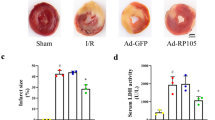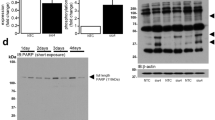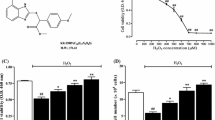Abstract
Peroxiredoxin II, a cytosolic isoform of the antioxidant enzyme family, has been implicated in cancer-associated cell death and apoptosis, but its functional role in the heart remains to be elucidated. Interestingly, the expression levels of peroxiredoxin II were decreased in mouse hearts upon ischemia-reperfusion, while they were elevated in two genetically modified hyperdynamic hearts with phospholamban ablation or protein phosphatase 1 inhibitor 1 overexpression. To delineate the functional significance of altered peroxiredoxin II expression, adenoviruses encoding sense or antisense peroxiredoxin II were generated; cardiomyocytes were infected, and then subjected to H2O2 treatment to mimic oxidative stress-induced cell death and apoptosis. H2O2 stimulation resulted in a significant decrease of endogenous peroxiredoxin II expression, along with reduced cell viability in control cells. However, overexpression of peroxiredoxin II significantly protected from H2O2-induced apoptosis and necrosis, while downregulation of this enzyme promoted the detrimental effects of oxidative stress in cardiomyocytes. The beneficial effects of peroxiredoxin II were associated with increased Bcl-2 expression, decreased expression of Bax and attenuated activity of caspases 3, 9 and 12. Furthermore, there were no significant alterations in the expression levels of the other five isoforms of peroxiredoxin, as well as active catalase or glutathione peroxidase-1 after ischemia-reperfusion or H2O2 treatment. These findings suggest that peroxiredoxin II may be a unique antioxidant in the cardiac system and may represent a potential target for cardiac protection from oxidative stress-induced injury.







Similar content being viewed by others
References
Bao J, Sato K, Li M, Gao Y, Abid R, Aird W, Simons M, Post MJ (2001) PR-39 and PR-11 peptides inhibit ischemia-reperfusion injury by blocking proteasome-mediated I kappa B alpha degradation. Am J Physiol Heart Circ Physiol 281:H2612–2618
Campbell B, Adams J, Shin YK, Lefer AM (1999) Cardioprotective effects of a novel proteasome inhibitor following ischemia and reperfusion in the isolated perfused rat heart. J Mol Cell Cardiol 31:467–476
Casey TM, Arthur PG, Bogoyevitch MA (2007) Necrotic death without mitochondrial dysfunction-delayed death of cardiac myocytes following oxidative stress. Biochim Biophys Acta 1773:342–351
Chen HW, Chien CT, Yu SL, Lee YT, Chen WJ (2002) Cyclosporine A regulate oxidative stress-induced apoptosis in cardiomyocytes: mechanisms via ROS generation, iNOS and Hsp70. Br J Pharmacol 137:771–781
Choi MH, Lee IK, Kim GW, Kim BU, Han YH, Yu DY, Park HS, Kim KY, Lee JS, Choi C, Bae YS, Lee BI, Rhee SG, Kang SW (2005) Regulation of PDGF signalling and vascular remodelling by peroxiredoxin II. Nature 435:347–353
Chu G, Kerr JP, Mitton B, Egnaczyk GF, Vazquez JA, Shen M, Kilby GW, Stevenson TI, Maggio JE, Vockley J, Rapundalo ST, Kranias EG (2004) Proteomic analysis of hyperdynamic mouse hearts with enhanced sarcoplasmic reticulum calcium cycling. FASEB J 18:1725–1727
Cullingford TE, Wait R, Clerk A, Sugden PH (2006) Effects of oxidative stress on the cardiac myocyte proteome: modifications to peroxiredoxins and small heat shock proteins. J Mol Cell Cardiol 40:157–172
Dhalla NS, Elmoselhi AB, Hata T, Makino N (2000) Status of myocardial antioxidants in ischemia-reperfusion injury. Cardiovasc Res 47:446–456
Divald A, Powell SR (2006) Proteasome mediates removal of proteins oxidized during myocardial ischemia. Free Radic Biol Med 40:156–164
Doll D, Sarikas A, Krajcik R, Zolk O (2007) Proteomic expression analysis of cardiomyocytes subjected to proteasome inhibition. Biochem Biophys Res Commun 353:436–442
Dost T, Cohen MV, Downey JM (2008) Redox signaling triggers protection during the reperfusion rather than the ischemic phase of preconditioning. Basic Res Cardiol 103:378–384
Fan GC, Chu G, Mitton B, Song Q, Yuan Q, Kranias EG (2004) Small heat-shock protein Hsp20 phosphorylation inhibits beta-agonist-induced cardiac apoptosis. Circ Res 94:1474–1482
Fan GC, Gregory KN, Zhao W, Park WJ, Kranias EG (2004) Regulation of myocardial function by histidine-rich, calcium-binding protein. Am J Physiol Heart Circ Physiol 287:H1705–1711
Fan GC, Ren X, Qian J, Yuan Q, Nicolaou P, Wang Y, Jones WK, Chu G, Kranias EG (2005) Novel cardioprotective role of a small heat-shock protein, Hsp20, against ischemia/reperfusion injury. Circulation 111:1792–1799
Fan GC, Yuan Q, Song G, Wang Y, Chen G, Qian J, Zhou X, Lee YJ, Ashraf M, Kranias EG (2006) Small heat-shock protein Hsp20 attenuates beta-agonist-mediated cardiac remodeling through apoptosis signal-regulating kinase 1. Circ Res 99:1233–1242
Gao Y, Lecker S, Post MJ, Hietaranta AJ, Li J, Volk R, Li M, Sato K, Saluja AK, Steer ML, Goldberg AL, Simons M (2000) Inhibition of ubiquitin-proteasome pathway-mediated I kappa B alpha degradation by a naturally occurring antibacterial peptide. J Clin Invest 106:439–448
Giordano FJ (2005) Oxygen, oxidative stress, hypoxia, and heart failure. J Clin Invest 115:500–508
Griendling KK, FitzGerald GA (2003) Oxidative stress and cardiovascular injury: Part I: basic mechanisms and in vivo monitoring of ROS. Circulation 108:1912–1916
Hess ML, Manson NH (1984) Molecular oxygen: friend and foe. The role of the oxygen free radical system in the calcium paradox, the oxygen paradox and ischemia/reperfusion injury. J Mol Cell Cardiol 16:969–985
Ihara Y, Urata Y, Goto S, Kondo T (2006) Role of calreticulin in the sensitivity of myocardiac H9c2 cells to oxidative stress caused by hydrogen peroxide. Am J Physiol Cell Physiol 290:C208–221
Jang HH, Lee KO, Chi YH, Jung BG, Park SK, Park JH, Lee JR, Lee SS, Moon JC, Yun JW, Choi YO, Kim WY, Kang JS, Cheong GW, Yun DJ, Rhee SG, Cho MJ, Lee SY (2004) Two enzymes in one; two yeast peroxiredoxins display oxidative stress-dependent switching from a peroxidase to a molecular chaperone function. Cell 117:625–635
Kang PM, Haunstetter A, Aoki H, Usheva A, Izumo S (2000) Morphological and molecular characterization of adult cardiomyocyte apoptosis during hypoxia and reoxygenation. Circ Res 87:118–125
Kim H, Lee TH, Park ES, Suh JM, Park SJ, Chung HK, Kwon OY, Kim YK, Ro HK, Shong M (2000) Role of peroxiredoxins in regulating intracellular hydrogen peroxide and hydrogen peroxide-induced apoptosis in thyroid cells. J Biol Chem 275:18266–18270
Lee TH, Kim SU, Yu SL, Kim SH, Park DS, Moon HB, Dho SH, Kwon KS, Kwon HJ, Han YH, Jeong S, Kang SW, Shin HS, Lee KK, Rhee SG, Yu DY (2003) Peroxiredoxin II is essential for sustaining life span of erythrocytes in mice. Blood 101:5033–5038
Liu Y, Yang XM, Iliodromitis EK, Kremastinos DT, Dost T, Cohen MV, Downey JM (2008) Redox signaling at reperfusion is required for protection from ischemic preconditioning but not from a direct PKC activator. Basic Res Cardiol 103:54–59
Luo W, Grupp IL, Harrer J, Ponniah S, Grupp G, Duffy JJ, Doetschman T, Kranias EG (1994) Targeted ablation of the phospholamban gene is associated with markedly enhanced myocardial contractility and loss of beta-agonist stimulation. Circ Res 75:401–409
Maack C, O’Rourke B (2007) Excitation-contraction coupling and mitochondrial energetics. Basic Res Cardiol 102:369–392
Mangat R, Singal T, Dhalla NS, Tappia PS (2006) Inhibition of phospholipase C-gamma 1 augments the decrease in cardiomyocyte viability by H2O2. Am J Physiol Heart Circ Physiol 291:H854–860
Matsushima S, Ide T, Yamato M, Matsusaka H, Hattori F, Ikeuchi M, Kubota T, Sunagawa K, Hasegawa Y, Kurihara T, Oikawa S, Kinugawa S, Tsutsui H (2006) Overexpression of mitochondrial peroxiredoxin-3 prevents left ventricular remodeling and failure after myocardial infarction in mice. Circulation 113:1779–1786
Meiners S, Heyken D, Weller A, Ludwig A, Stangl K, Kloetzel PM, Kruger E (2003) Inhibition of proteasome activity induces concerted expression of proteasome genes and de novo formation of Mammalian proteasomes. J Biol Chem 278:21517–21525
Moon JC, Hah YS, Kim WY, Jung BG, Jang HH, Lee JR, Kim SY, Lee YM, Jeon MG, Kim CW, Cho MJ, Lee SY (2005) Oxidative stress-dependent structural and functional switching of a human 2-Cys peroxiredoxin isotype II that enhances HeLa cell resistance to H2O2-induced cell death. J Biol Chem 280:28775–28784
Nagy N, Malik G, Fisher AB, Das DK (2006) Targeted disruption of peroxiredoxin 6 gene renders the heart vulnerable to ischemia-reperfusion injury. Am J Physiol Heart Circ Physiol 291:H2636–2640
Park SH, Chung YM, Lee YS, Kim HJ, Kim JS, Chae HZ, Yoo YD (2000) Antisense of human peroxiredoxin II enhances radiation-induced cell death. Clin Cancer Res 6:4915–4920
Pathak A, Baldwin B, Kranias EG (2007) Key protein alterations associated with hyperdynamic cardiac function: insights based on proteomic analysis of the protein phosphatase 1 inhibitor-1 overexpressing hearts. Hellenic J Cardiol 48:30–36
Pathak A, del Monte F, Zhao W, Schultz JE, Lorenz JN, Bodi I, Weiser D, Hahn H, Carr AN, Syed F, Mavila N, Jha L, Qian J, Marreez Y, Chen G, McGraw DW, Heist EK, Guerrero JL, DePaoli-Roach AA, Hajjar RJ, Kranias EG (2005) Enhancement of cardiac function and suppression of heart failure progression by inhibition of protein phosphatase 1. Circ Res 96:756–766
Penna C, Mancardi D, Tullio F, Pagliaro P (2008) Postconditioning and intermittent bradykinin induced cardioprotection require cyclooxygenase activation and prostacyclin release during reperfusion. Basic Res Cardiol 103:368–377
Penna C, Rastaldo R, Mancardi D, Raimondo S, Cappello S, Gattullo D, Losano G, Pagliaro P (2006) Post-conditioning induced cardioprotection requires signaling through a redox-sensitive mechanism, mitochondrial ATP-sensitive K + channel and protein kinase C activation. Basic Res Cardiol 101:180–189
Powell SR, Wang P, Katzeff H, Shringarpure R, Teoh C, Khaliulin I, Das DK, Davies KJ, Schwalb H (2005) Oxidized and ubiquitinated proteins may predict recovery of postischemic cardiac function: essential role of the proteasome. Antioxid Redox Signal 7:538–546
Pye J, Ardeshirpour F, McCain A, Bellinger DA, Merricks E, Adams J, Elliott PJ, Pien C, Fischer TH, Baldwin AS, Jr., Nichols TC (2003) Proteasome inhibition ablates activation of NF-kappa B in myocardial reperfusion and reduces reperfusion injury. Am J Physiol Heart Circ Physiol 284:H919–926
Ruusalepp A, Czibik G, Flatebo T, Vaage J, Valen G (2007) Myocardial protection evoked by hyperoxic exposure involves signaling through nitric oxide and mitogen activated protein kinases. Basic Res Cardiol 102:318–326
Schroder E, Brennan JP, Eaton P (2008) Cardiac peroxiredoxins undergo complex modifications during cardiac oxidant stress. Am J Physiol Heart Circ Physiol 295:H425–433
Seddon M, Looi YH, Shah AM (2007) Oxidative stress and redox signalling in cardiac hypertrophy and heart failure. Heart 93:903–907
Seo MS, Kim JK, Lim Y, Kang SW, Cho YJ, Lee WK, Kim HJ, Cho KK, Lee KH, Rhee SG (1999) Rapid degradation of PrxI and PrxII induced by silica in Rat2 cells. Biochem Biophys Res Commun 265:541–544
Slack JP, Grupp IL, Dash R, Holder D, Schmidt A, Gerst MJ, Tamura T, Tilgmann C, James PF, Johnson R, Gerdes AM, Kranias EG (2001) The enhanced contractility of the phospholamban-deficient mouse heart persists with aging. J Mol Cell Cardiol 33:1031–1040
Stangl K, Gunther C, Frank T, Lorenz M, Meiners S, Ropke T, Stelter L, Moobed M, Baumann G, Kloetzel PM, Stangl V (2002) Inhibition of the ubiquitin-proteasome pathway induces differential heat-shock protein response in cardiomyocytes and renders early cardiac protection. Biochem Biophys Res Commun 291:542–549
Suzuki YJ, Ford GD (1999) Redox regulation of signal transduction in cardiac and smooth muscle. J Mol Cell Cardiol 31:345–353
Tsutsui H, Ide T, Kinugawa S (2006) Mitochondrial oxidative stress, DNA damage, and heart failure. Antioxid Redox Signal 8:1737–1744
Vafiadaki E, Sanoudou D, Arvanitis DA, Catino DH, Kranias EG, Kontrogianni-Konstantopoulos A (2007) Phospholamban interacts with HAX-1, a mitochondrial protein with anti-apoptotic function. J Mol Biol 367:65–79
Venardos KM, Perkins A, Headrick J, Kaye DM (2007) Myocardial ischemia-reperfusion injury, antioxidant enzyme systems, and selenium: a review. Curr Med Chem 14:1539–1549
Wang X, Phelan SA, Forsman-Semb K, Taylor EF, Petros C, Brown A, Lerner CP, Paigen B (2003) Mice with targeted mutation of peroxiredoxin 6 develop normally but are susceptible to oxidative stress. J Biol Chem 278:25179–25190
Watabe S, Hasegawa H, Takimoto K, Yamamoto Y, Takahashi SY (1995) Possible function of SP-22, a substrate of mitochondrial ATP-dependent protease, as a radical scavenger. Biochem Biophys Res Commun 213:1010–1016
Witting PK, Liao WQ, Matthew JH, Neuzil J (2006) Expression of human myoglobin in H9c2 cells enhances toxicity to added hydrogen peroxide. Biochem Biophys Res Commun 348:485–493
Yaniv G, Shilkrut M, Larisch S, Binah O (2005) Hydrogen peroxide predisposes neonatal rat ventricular myocytes to Fas-mediated apoptosis. Biochem Biophys Res Commun 336:740–746
Zhang P, Liu B, Kang SW, Seo MS, Rhee SG, Obeid LM (1997) Thioredoxin peroxidase is a novel inhibitor of apoptosis with a mechanism distinct from that of Bcl-2. J Biol Chem 272:30615–30618
Zorov DB, Filburn CR, Klotz LO, Zweier JL, Sollott SJ (2000) Reactive oxygen species (ROS)-induced ROS release: a new phenomenon accompanying induction of the mitochondrial permeability transition in cardiac myocytes. J Exp Med 192:1001–1014
Acknowledgments
This study was supported by NIH grants HL-26057, HL-64018, HL-77101 and the Leducq Foundation (to E.G.K), and by NIH grant HL-087861 (Dr. G. C. Fan).
Author information
Authors and Affiliations
Corresponding author
Additional information
Returned for 1. Revision: 14 April 2008 1. Revision received: 25 September 2008
Rights and permissions
About this article
Cite this article
Zhao, W., Fan, GC., Zhang, ZG. et al. Protection of peroxiredoxin II on oxidative stress-induced cardiomyocyte death and apoptosis. Basic Res Cardiol 104, 377–389 (2009). https://doi.org/10.1007/s00395-008-0764-6
Received:
Accepted:
Published:
Issue Date:
DOI: https://doi.org/10.1007/s00395-008-0764-6




